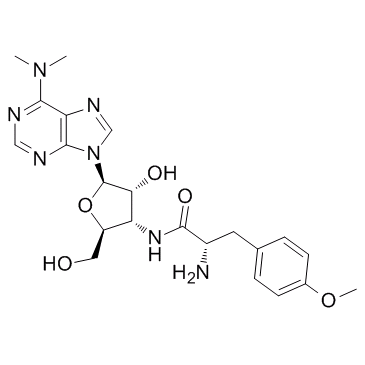Puromycin (CL13900) |
| Katalog-Nr.GC32186 |
Puromycin-Dihydrochlorid ist das Dihydrochloridsalz von Puromycin. Puromycin ist ein Aminoglykosid-Antibiotikum, das die Proteinsynthese hemmt.
Products are for research use only. Not for human use. We do not sell to patients.

Cas No.: 53-79-2
Sample solution is provided at 25 µL, 10mM.
Puromycin dihydrochloride is the dihydrochloride salt of puromycin. Puromycin is an aminoglycoside antibiotic that inhibits protein synthesis.
Puromycin blocks protein synthesis after aminoacyl-sRNA formation, and at the same time it leads to the accumulation of small peptides. Both of these effects appear to be due to the splitting of ribosome-bound peptidyl-sRNA,4 which results in release of incomplete peptide chains.[1]. Puromycin, an analog of the 3’ end of aminoacyl-tRNA, causes premature termination of translation by being linked non-specifically to growing polypeptide chains. Puromycin has two modes of inhibitory action. The first is by acting as an acceptor substrate which attacks peptidyl-tRNA in the P site to form a nascent peptide. The second is by competing with aminoacyl-tRNA for binding to the A’ site[2]. When used in minimal amounts, puromycin incorporation in neosynthesized proteins reflects directly the rate of mRNA translation in vitro. Puromycin immunodetection is an advantageous alternative to radioactive amino acid labeling. It allows the direct evaluation of translation activity in single cells by immunofluorescence microscopy and in heterogenous populations of cells by fluorescenceactivated cell sorting[3].
References:
[1]. Nathans D, et al. Puromycin inhibition of protein synthesis: incorporation of puromycin intopeptide chains. Proc Natl Acad Sci U S A. 1964 Apr;51:585-92.
[2]. Miyamoto-Sato E, et al. Specific bonding of puromycin to full-length protein at the C-terminus. Nucleic Acids Res. 2000 Mar 1;28(5):1176-82.
[3]. Schmidt EK, et al. SUnSET, a nonradioactive method to monitor protein synthesis. Nat Methods. 2009 Apr;6(4):275-7.
| Cas No. | 53-79-2 | SDF | |
| Canonical SMILES | OC[C@@H]1[C@@H](NC([C@@H](N)CC2=CC=C(OC)C=C2)=O)[C@H]([C@H](N3C=NC4=C3N=CN=C4N(C)C)O1)O | ||
| Formula | C22H29N7O5 | M.Wt | 471.51 |
| Löslichkeit | Soluble in DMSO | Storage | Store at -20°C |
| General tips | Please select the appropriate solvent to prepare the stock solution according to the
solubility of the product in different solvents; once the solution is prepared, please store it in
separate packages to avoid product failure caused by repeated freezing and thawing.Storage method
and period of the stock solution: When stored at -80°C, please use it within 6 months; when stored
at -20°C, please use it within 1 month. To increase solubility, heat the tube to 37°C and then oscillate in an ultrasonic bath for some time. |
||
| Shipping Condition | Evaluation sample solution: shipped with blue ice. All other sizes available: with RT, or with Blue Ice upon request. | ||
| Prepare stock solution | |||

|
1 mg | 5 mg | 10 mg |
| 1 mM | 2.1208 mL | 10.6042 mL | 21.2085 mL |
| 5 mM | 0.4242 mL | 2.1208 mL | 4.2417 mL |
| 10 mM | 0.2121 mL | 1.0604 mL | 2.1208 mL |
Step 1: Enter information below (Recommended: An additional animal making an allowance for loss during the experiment)
 g
g
 μL
μL

Step 2: Enter the in vivo formulation (This is only the calculator, not formulation. Please contact us first if there is no in vivo formulation at the solubility Section.)
Calculation results:
Working concentration: mg/ml;
Method for preparing DMSO master liquid: mg drug pre-dissolved in μL DMSO ( Master liquid concentration mg/mL, Please contact us first if the concentration exceeds the DMSO solubility of the batch of drug. )
Method for preparing in vivo formulation: Take μL DMSO master liquid, next addμL PEG300, mix and clarify, next addμL Tween 80, mix and clarify, next add μL ddH2O, mix and clarify.
Method for preparing in vivo formulation: Take μL DMSO master liquid, next add μL Corn oil, mix and clarify.
Note: 1. Please make sure the liquid is clear before adding the next solvent.
2. Be sure to add the solvent(s) in order. You must ensure that the solution obtained, in the previous addition, is a clear solution before proceeding to add the next solvent. Physical methods such as vortex, ultrasound or hot water bath can be used to aid dissolving.
3. All of the above co-solvents are available for purchase on the GlpBio website.
Quality Control & SDS
- View current batch:
- Purity: >98.00%
- COA (Certificate Of Analysis)
- SDS (Safety Data Sheet)
- Datasheet
Average Rating: 5 (Based on Reviews and 3 reference(s) in Google Scholar.)
GLPBIO products are for RESEARCH USE ONLY. Please make sure your review or question is research based.
Required fields are marked with *



